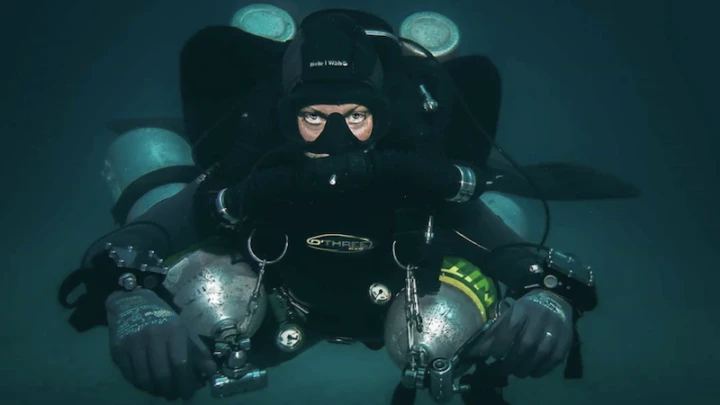Technical diving is growing in popularity and it didn’t take long until it grabbed our attention here at Girls that Scuba HQ! But we had a lot of questions first and a few nerves so we headed to the woman in the know – one of the only female tech instructors in Asia – Theresia Gollner – who is working at Blue Marlin in Gili T, Lombok. She gave us an intro course to twin sets and let us into the wonderful world of technical diving. Here’s what she taught us:
What on earth is technical diving?
The very general definition of technical diving is to be exposed to a ceiling that does not allow a diver to ascend to the surface at any moment of the dive. This might be due to a real ceiling, in terms of a cave or a wreck, or a virtual ceiling created by a decompression obligation. In this case, by exceeding the NDL’s, mandatory decompression stops have to be performed on ascent in order to avoid any case of decompression sickness. In most cases this requires the use of special equipment, e.g. Twinsets or Sidemount, special gas mixes and of course additional training to be able to perform those stops accurately on ascent to optimize off-gassing of Nitrogen.
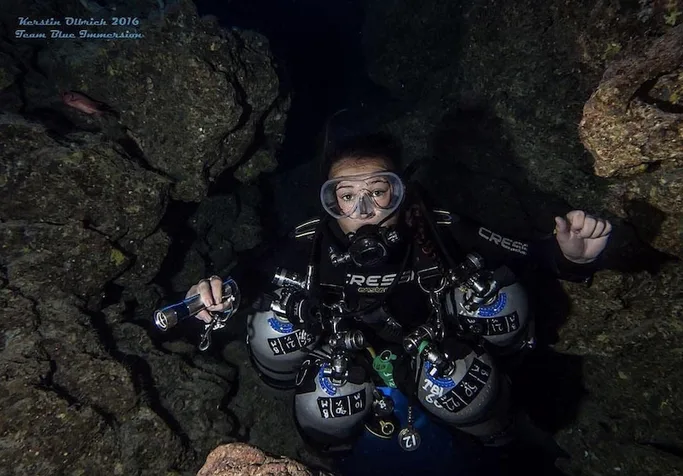
Technical diving configurations
There is a wide variety of equipment that is used by technical divers the biggest impact on the decision is the environment a diver is exposed to. Many cave divers prefer to use Sidemount which means, independent single tanks are mount to the side of the divers’ body and attached by clips on a D-Ring on the waist band on the harness and on the shoulder. This allows the diver to detach and don tanks to fit thru tiny restrictions and have a lower overall profile to go to places unreachable for divers who chose backmount. During multiple trips, additional tanks can be placed in a cave or a wreck to allow the diver deeper penetration dives and to pick up tanks when leaving the cave or wreck.
Twinsets on the other hand are two tanks attached to the back of the diver and are usually connected with each other thru a manifold. This means a diver can access to both tanks using a single regulator.
And then there are the rebreathers…a rebreather is a machine that recycles exhaled gas and is the preferred method for ‘very’ deep dives in order to use the gas carried more efficiently. In this case the exhaled gas is going thru a canister filled with a chemical which is called Sofnolime or scrubber to remove CO2 from the breathing loop and the remaining gas will be inhaled again by the diver. Metabolised oxygen is replaced into the loop to keep the oxygen content in the divers’ body at the desired pressure.
What are advantages and disadvantages for each?
Depending on the environment and type of diving each configuration has its advantage and disadvantage. Diving in caves or wrecks the preferred way to dive for sure is either Sidemount or rebreathers. There is also an option for a Sidemount rebreather which makes the diver more streamlined to fit through narrow restrictions. Sidemount also gives the diver the advantage to leave tanks behind that will be picked up upon exiting the cave or wreck. To fit through narrow bedding planes unclipping the tanks makes the profile of the diver even smaller and places that are not available to a backmounted twinset diver become accessible.
In general Sidemount is more task loading for a diver as the pressure in each tank needs to be balanced in order to have enough gas for an out of air diver and to be balanced on each side.
A Twinset diver will always be able to access to both tanks from one single regulator as long as the manifold, or the connection between both tanks is open. To carry a twinset for a smaller person might be a challenge on land. It is quite heavy and sidemounted tanks can be carried individually which sometimes makes it easier to access remote areas or steep slopes to access the water.
The freedom of movement of the head for sidemount divers is very attractive where a twinset can always be felt in the neck by a diver…something to get used to.
Whatever configuration a diver chooses there is benefits for each and in different situations each configuration has its up or downside.
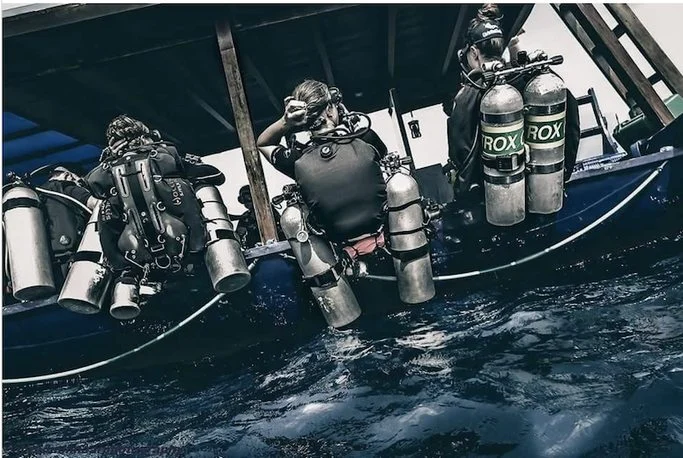
Gas mixes
Different depths require the use of different gas mixes. The maximum partial pressure of oxygen a diver wants to dive at is 1.4 which is reached on air at 56m. Due to the water pressure the pressure of each individual gas increases and therefore we need to use appropriate mixes if we choose to go deeper. In general, the more oxygen a gas mix has the less deep we can go. A tech diver will use low oxygen mixes at depth and high oxygen mixes coming up shallower to off-gas Nitrogen faster and decrease the mandatory decompression time overall.
For dives deeper than 56m gas mixes called Trimix are used. In order to reduce narcosis and reduce the toxic effects of Nitrogen and Oxygen, Helium is added which has no negative effect on our body to very deep depth. There are additional risks with helium but those start at depths of around 180m. In history tests have been executed with different noble gasses, however they all turned out to be toxic for the human body, so helium was the only one adequate for diving. One other gas that has no effect on the human body is Hydrogen but due to its high risk of fire and explosion in contact with oxygen, the blending of it is very difficult if not almost impossible with the techniques we use currently.
With a formula, the perfect gas mix can be calculated for every single depth.
What are the risks of technical diving and why is training so important
One of the big risks for a technical diver is decompression sickness. It occurs when nitrogen gas cannot exit the body thru respiration on ascent as the ambient pressure decreases. Therefore stops have to be executed on ascent in order to avoid a pressure difference too big so nitrogen bubbles can be formed. Buoyancy control is very important to control the stops on ascent and increase efficiency for off-gassing of nitrogen. Another important skill is proper breathing which makes metabolism efficient. Trim, which we call a proper tech diving position such as horizontal with a slight arch in the back, looking forward and knees at a 90 degree angle with fins pointing back. Trim prevents stirring up sediments on the bottom as well as most efficient movement in the water. And of course proper finning techniques to avoid overexertion are mandatory to make a diver achieve maximum performance. Now you might say, we want to have fun when we go diving and not be a machine.
However it is important at greater depths to decrease effort and achieve maximum performance to avoid overexertion and CO2 buildup. CO2 is the trigger for our breathing reflex, so the more CO2 we build up the more we will feel the urge to breathe. This means in the same amount of time we will pump more gas through our lungs and we take in more gas in the same amount of time.
Some other risks include Oxygen Toxicity and Narcosis. Please refer to DAN to find out more about these.
Book recommendations
There are many great readings about technical diving. Some are stories of personal experiences and adventures in technical diving that are definitely worth reading. Some of the greatest books for sure are:
‘Caverns Measureless to Men’ by Sheck Exley, one of the pioneers of cave diving in Florida, USA. He also wore ‘Basic Cave Diving: A Blueprint for Survival’ which studies many cave diving accidents.
‘Shadow Divers’ by Robert Kurson is about the identification of a German submarine that was tried to be identified by John Chatterton and his crew during almost a decade.
‘Diving into Darkness’ by Phillip Finch is telling the story about an Australian cave diver trying to recover a body in a South African cave called Bushman’s hole.
Some other wreck diving books are ‘The Last Dive’ by Bernie Chowdhury about father and son who are crazy about wrecks and eventually find their destiny on a German U-boat.
And of course, the book of Verna Van Schaik ‘Fatally Flawed – The Quest to be Deepest’, the one woman who succeeded to break the female world record in depth in Bushman’s hole in South Africa and how she god there.
A great fact book about technical diving is ‘Deco for Divers – A Guide to Decompression Theory and Physiology’ written by Mark Powell.
Equipment
The choice of equipment is very individual and different divers will recommend different styles. In general to go with a well known brand is useful as they stand for quality, performance and configurability. Some of the best brands are Apeks, Diverite, Halcyon, OMS, Scubapro, Hollis and some newer brands like xDeep or Tecline. The preferred divecomputers for tech divers at the moment are Shearwater products, whether it be the Petrel 2 or Perdix, the flexibility of the algorithm, handling and display.
For more women diving equipment recommendations check out our guide.
Technical training agencies
TDI – Technical Diving International
TDI is an American tech diving organization that was found in 1994 and has instructors all around the world. The prerequisite to start technical diving with a TDI instructor are the Advanced Open Water certification of any organization, Nitrox certified and a minimum of 25 dives. The first technical diving courses are TDI Sidemount (within No deco limits) and Advanced Nitrox and Decompression Procedures allowing to dive to 45m, using oxygen mixes up to 100% of oxygen and doing staged decompression stops. The course contents include theory, pool work, and a minimum of 6 dives depending on your level of comfort in the water in order to be able to complete all open water requirements safely and efficiently and to understand planning and preparation of a technical dive.
GUE – Global Underwater Explorers
With GUE as a non-diver, the first levels to be completed before a technical diver training are Recreational Diver 1 to a maximum depth of 21m. After completing the course the Fundamental Rec Pass can be completed which is teaching the basic fundamental skills for a diver and prepares the diver for the Fundamental Tech Pass.
After successful completion, the Tech Diver Level 1 can be started and allows a diver to dive to 51m using appropriate Trimix gas mixes beyond 30m. It is also possible to start Cave Diving Training after the Fundamental Tech Pass.
After completing the Tech Diver Level 2 to a depth of 75m, the step towards rebreather diving is possible.
Tec 40 is the first step to start the TecRec program with Padi. The prerequisites are Advanced Open Water and Deep Diver certifications as well as Nitrox. In addition to that, before starting the course a minimum of 10 Nitrox dives have to be proved. The certification allows divers to dive to 40m doing limited decompression using gas mixes up to 50% of oxygen. The Tec 40 is also the prerequisite to continue with Padi Tec 45 which allows to do unlimited decompression time as long as it is carefully planned. The next step will be Tec 50 that enhances the allowable depth to 50m.
There are several more agencies that provide technical diver training which are more region specific. In general the recommendation is to find a reputable instructor, look for recommendations from trusted sources and choose your instructor accordingly. Trust and comfort during the course are invaluable and will help you to feel confident and comfortable to push your boundaries and gain the knowledge you need to go beyond your current certification level.
During the training, the instructor will provide you with the tools to complete the dives within the certification range, however it is up to you to gain experience and practice skills after the course to become automatic and an efficient and professional tech diver.
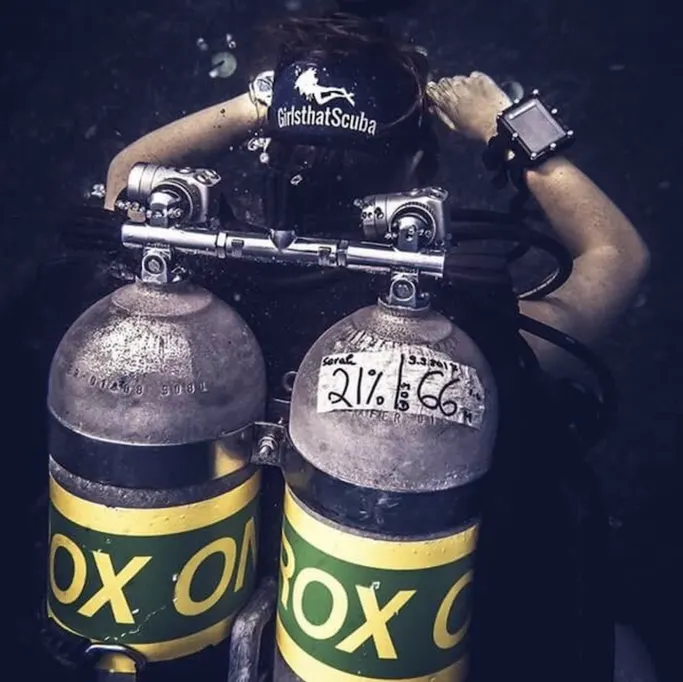
Are you ready to start Technical Diving?
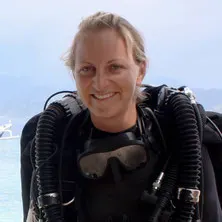
Written by Theresia Gollner, TDI Technical Dive instructor with Blue Marlin in Gili Trawangan, Lombok, Indonesia. Go and say hi to her when you are in Gili T and why not start your introduction to technical diving? You can follow Theresia on Instagram here

